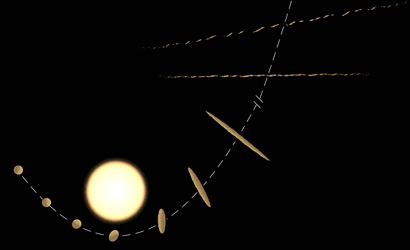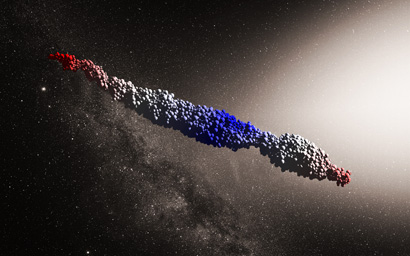
Andy Lloyd's Dark Star Blog

Blog 80 (April-June 2020)
Stellar 'Bat Wings'
It was bizarre enough back in 2018 when the Hubble Space Telescope imaged batwing-like shadows across a dust cloud (1). It was a fun finding to release on Hallowe'en. The shadow effect seems to have been caused by star light being blocked by an elongate protoplanetary dust disk. This creates a shadow across the otherwise illuminated background nebula dust clouds. It turns out that this shadow has been flapping (and this time it's not even Hallowe'en!) (2).
The movement of the shadows projected across the lighter nebula behind the star, HBC 672, is very slow, but nonetheless discernable over the course of a year or so. HubbleESA have released an animation on YouTube to show how they think this effect has been generated by the star's curvaceous dust cloud (3). Scientists suspect that a planet moving in a tilted orbit around the star is distorting the remaining disk causing a slow motion undulating wave-like effect. In turn, the curved disk blocks the star's light as it projects back towards the lighter nebula cloud behind it, and this causes the 'flapping' of the batwing shadows. The scale of the shadows is staggering: about 200 times the size of the solar system. The light from the star takes 45 light days to reach the nebula.
Image Credit: NASA, ESA, and STScI
Of interest to me here is the warped nature of the dust cloud circling the HBC 672. I have speculated that a Planet X body is likely surrounded by a substantial dust disk of materials, from Saturn-ring like ice crystals right up to a system of moons. Beyond the Sun's heliosphere, that circumplanetary dust would not disperse in the same way that dust is removed from around the familiar planets (4). Instead, it would become a permanent feature, replenished and invigorated when the Sun periodically passes through dusty regions of the galaxy.

The appearance of this cosmic conglomeration would be like the ancient 'Winged' Disk' symbols from Egypt and Mesopotamia. In HBC 672, we can see such a magnificent spectacle realised, projected onto a stunning nebula backdrop. Of course, in our own solar system, Planet X is enshrouded in darkness, devoid of the light and background required to generate any noticeable effect. But should that object have skirted closer to the Sun, comet-like, then I suspect its appearance would have been similarly suitable for a Hallowe'en Hubble post. Maybe a bat, more likely a cosmic dragon... There's a lot of potential mythology that plays into this!
If this speculation on my part is found to be true one day, then what HBC 672 tells us is that the cloud disk is being distorted by a moon orbiting at an inclination to the circumplanetary disk. Which leads us to other intriguing aspects of my Dark Star Theory, like the warming of moons orbiting a substantial Planet X body (5).
Written by Andy Lloyd,
30th June 2020References:
1) NASA "Hubble Reveals a Giant Cosmic 'Bat Shadow'" 31 October 2018
2) ESA/Hubble Information Centre "Hubble sees a cosmic flapping 'Bat Shadow'" 25 June 2020
3) HubbleESA "Animation: The Bat Shadow’s “Flapping” Motion Explained" 25 June 2020
4) Andy Lloyd "Darker Stars" Timeless Voyager Press, 2018
5) Andy Lloyd "Dark Star: The Planet X Evidence" Timeless Voyager Press, 2005
OSSOS Scientist debunks Planet Nine
Four years on, and counting. Still no sign of Planet X (in its modern astronomical guise 'Planet Nine'). The natives are restless, and the provision of more KBO data over the last year or so is raising questions about the validity of that all important 'cluster'. Great claims were made for the remarkably aligned orbital pericentres of the extended scattered disk objects lying beyond the Kuiper Belt - the statistical likelihood of one crucial aspect of their orbits could not simply be put down to coincidence, argued Caltech planet hunter Mike Brown and his dynamicist colleague Konstantin Batygin (1). The cluster implied a hidden presence lurking beyond - the mythical Planet X, which they re-branded as Planet Nine. Finally, some real evidence for the much-maligned Planet X!
Naturally, such a contentious viewpoint, emerging as it did from within the heart of the astrophysics community, would not be without its detractors. Perhaps this 'phenomenon' could be put down to observational bias, due to the seasonal variation in ground-based telescope observations. Perhaps the phenomenon was real enough, but might have been cause by something other than a rogue planet, like an early flyby of a star disrupting the solar system's second asteroid belt, or planetary migration early in the solar system's history. Some of these arguments were made by members of OSSOS, an international research team of 40 researchers from eight countries, hunting distant small bodies in the outer solar system. They, too, are experts in this starfield.
Image Credit: Samantha Lawler
OSSOS and the Caltech Team have been arguing about this for a few years (2). Recently, a carefully argued an opinion piece written by one of the OSSOS team essentially debunks Planet Nine. There is no right of reply in this piece, which is to be expected in a commentary. It was initially published in 'The Conversation' (3). However, the piece has also been presented by PhysOrg and comes across if it is one of their regular news reports (4). This gives the impression of a degree of journalistic objectivity. Professor Lawler presents a technical and detailed argument about the issues the Planet Nine hypothesis faces, but there is more than a whiff of debunkery here, in my honest opinion.
Lawler's sceptical article raises science questions Planet Nine scientists need to address (again). After all, OSSOS and the Dark Energy Survey (DES) have diligently supplied astronomers with a mass of new distant objects to consider. Nonetheless, these are not arguments that are new to Batygin, who makes the same point:
"Well..the recurring planet-nine-is-not-real-because-of-observational-bias narrative has made its comeback yet again (+new KBOs that actually also cluster...). Obs bias is important, and @plutokiller & I looked into this back in '18. And the probability that this is a fluke." (5)
He also makes the almost self-evident point that the new objects also appear to cluster, as can be seen from the infographic Lawler presents. I suspect there's still more in the maths!
Written by Andy Lloyd,
31st May 2020References:
1) Konstantin Batygin & Michael Brown "Evidence for a Distant Giant Planet in the Solar System" The Astronomical Journal, 151:2, 20 January 2016,
2) Josh Sokol "New haul of distant worlds casts doubt on Planet Nine", 21 June 2017
3) Samantha Lawler "Why astronomers now doubt there is an undiscovered 9th planet in our solar system" 25 May 2020
4) Samantha Lawler "Why astronomers now doubt there is an undiscovered 9th planet in our solar system" 25 May 2020 with thanks to John
5) Konstantin Batygin, @kbatygin 31 May 2020
A Blunderbuss of Cosmic Clocks
Finding Planet X continues to prove tricky. This elusive object is
so far away (>500AU, and possibly quite a way further out than even
that) that its reflected light is extremely dim. Worse, because of
the distances involved, its lateral movement across the sky is also very
slow, making its perceived movement against the backdrop of background
stars tricky too. Nonetheless, there is plenty of solid indirect
evidence for its existence, enough for astrophysicists to revitalise the
search for X under the re-branded name 'Planet Nine'.
At the present time, it is not known whereabouts in the sky planet X
resides. The indirect evidence for its existence involves the
gravitational effect it invokes upon other objects in the outer solar
system, but their orbital dynamics have been carved out over the eons in
response to this effect, preventing any realistic triangulation of its
position. The 'clustering' of extended scattered disk objects
beyond Neptune discussed above may point in a general direction but sky
searches have yet to lead to Planet X's discovery.
What other means are available to find this mysterious world?
Could its position be triangulated by artificial means? In the
1970s, probes were sent out through the outer solar system and their
movements towards the edge of the solar system continue to be monitored.
At one point, a persistent positional anomaly of a Pioneer probe led
some scientists to speculate that its trajectory had been affected by a
distant Planet X body, although the Pioneer anomaly has since been
linked to radiation pressure caused by the spacecraft's heat loss.
Still, the idea for trying to triangulate the position of Planet X
stands on a theoretical level - the problem is the lack of spacecraft
exiting through the zone this object purportedly occupies.
Image Credit: Breakthrough Initiatives
Enter some brave new thinking. Venture capitalism and space exploration seem to be eager bedfellows these days, and one potential future development could use 'starshot', as envisioned by the Breakthrough Initiatives:
"In the last decade and a half, rapid technological advances have opened up the possibility of light-powered space travel at a significant fraction of light speed. This involves a ground-based light beamer pushing ultra-light nanocrafts – miniature space probes attached to lightsails – to speeds of up to 100 million miles an hour. Such a system would allow a flyby mission to reach Alpha Centauri in just over 20 years from launch, beaming home images of its recently-discovered planet Proxima b, and any other planets that may lie in the system, as well as collecting other scientific data such as analysis of magnetic fields." (1)
These craft amount to little more than "tiny probes equipped with only clocks and radio transmitters" (2). Beyond the exciting possibility of reaching out to other stars, the transit through the outer solar system of this stellar grapeshot would create a more detailed gravitational map of that environment. This possibility has not been lost on scientists, bringing forth unpublished work setting out how the position of a Planet X body (or equivalent gravitational anomaly) might be determined from various flybys of 'starshot' (3).
Written by Andy Lloyd,
30th June 2020References:
1) Breakthrough Initiatives "Starshot"
breakthroughinitiatives.org/initiative/3
2) Caroline Delbert "If Planet 9 Really Exists, Here's the Wild Way We Could Hunt It" 25 May 2020 with thanks to Lee
3) Edward Witten "Searching for a Black Hole in the Outer Solar System" 2 May 2020
Formation of an Interstellar Visitor
The origins of the solar system's first documented interstellar visitor, ‘Oumuamua (1I/2017 U1), remains mysterious. Although astronomers had long expected to spot and identify interstellar comets, when they actually found one it turned out to be remarkably bizarre. They could tell from its periodically oscillating light that the fast-moving reddish object was very elongated, and was tumbling 'head over foot' as it skirted around the Sun at perihelion. Not at all like the relatively rounded comet objects one might expect (even though some end up shaped more like rubber ducks!)

Image Credit: NAOC/Y. Zhang
Additionally, this Manx cat-like 'comet' emitted no significant tail of gas. This made it seem more like an asteroid. This feature caused some considerable difficulties for astrophysicists. An asteroid would need to have been ejected from within a star's tightly-knit planetary system, rather than having been lost from the peripheries of a comet cloud. If ‘Oumuamua was even remotely representative of many interstellar objects, then that would have massive implications for scientific understanding of the chaotic early life of a star system. Such objects, essentially asteroids having been ejected into interstellar space, should be very, very rare. What's the chances of one of these objects being our only known example of an interstellar object? (Now we have 2I/Borisov to compare 1I/‘Oumuamua to, and the former seems a lot more like a 'normal' comet.)

Image credit: NAOC/Y. Zhang; background: ESO/M. Kornmesser
So, astrophysicists could be forgiven for wanting to
normalise ‘Oumuamua. An international team has used computer
models to try to create ‘Oumuamua from a set of working assumptions
about how the gravity of a parent star might pull apart fledgling bodies
moving around it (1). Their hope was to mimic the curious
shard-like shape of ‘Oumuamua, as well as setting up some of its
physical properties which might explain its odd behaviours.
Importantly, the modelling needed to show how relatively close
encounters between small planetessimals and their parent star could
explain a potentially massive population of ejected interstellar
objects: "...researchers have
calculated that there must be an extremely large population of
interstellar objects like ‘Oumuamua. “The discovery of ‘Oumuamua implies
that the population of rocky interstellar objects is much larger than we
previously thought,” [Yun] Zhang [of the National
Astronomical Observatories of the Chinese Academy of Sciences]
The tidal disruption scenario appears to have produced these kinds of objects from, potentially, a range of starting materials. This is because young comets, as well as young asteroids, are capable of swinging around youthful stars, becoming broken up into 'extremely elongated shapes' as they do so. This catastrophic flyby can then propel the fragments into the cosmos:
"We infer that the progenitors of ‘Oumuamua-like ISOs may be kilometre-sized long-period comets from Oort clouds, kilometre-sized residual planetesimals from debris disks or planet-sized bodies at a few astronomical units, orbiting around low-mass main-sequence stars or white dwarfs. These provide abundant reservoirs to account for ‘Oumuamua’s occurrence rate." (2)
Furthermore, the thermal effect of the disruptive perihelion transit plunders the object of its volatiles, rendering it largely dry, save for small reservoirs of condensed volatiles stored within the fragment's shell. The release of this small quantity of gas could go unseen, yet might explain, in ‘Oumuamua's case, its quirky exit trajectory (odd enough for some to speculate about it being an artificial object (3)). It seems as though this computer modelling might tie everything up quite neatly. But, as noted already, there have only been two identified interstellar objects to date. Therefore, the distribution of interstellar objects is still very much 'up in the air'.
Written by Andy Lloyd,
15th April 2020References:
1)
Tim Stephens "New formation theory explains the mysterious interstellar object ‘Oumuamua" 13 April 20202) Yun Zhang & Douglas Lin "Tidal fragmentation as the origin of 1I/2017 U1 (‘Oumuamua)" Nature, 13 April 2020,
3) Shmuel Bialy & Abraham Loeb "Could Solar Radiation Pressure Explain 'Oumuamua's Peculiar Acceleration?" The Astrophysical Journal Letters, 12 November 2018

You can keep informed of updates by following me on Twitter:
![]()
Or like my Facebook Page: https://www.facebook.com/darkstarandylloyd